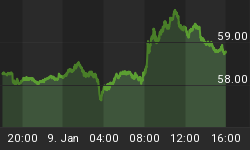Since July 2007 we have had an upside Dow theory non-confirmation, followed by a bearish primary trend change that was followed by a downside non-confirmation out of the January/March secondary lows. This was all then followed by a rally into the most recent secondary high points that carried the Transports to a new closing high on June 5, 2008 while the Industrials have lagged. As a result, another upside non-confirmation has been form. This can all be seen in the Dow theory chart below.

Let's begin with some words from Robert Rhea, who was the leading Dow theorist in the late 1920's and 30's and who also did far more work to further what has become known as the Dow theory than any of the other Dow theorists of that era. Anyway, Rhea states that under Dow's theory the primary trend, once authoritatively established, is considered to be continuing in force until negated by a confirmed indication.
There is still the possibility that this bearish primary trend change might have occurred within the context of a longer-term bull market as was discussed here in late May. However, to date nothing has occurred to negate the bearish primary trend change that occurred on November 21, 2007. So, until the bearish primary trend, that was established on November 21, 2007 is negated, there is not sufficient evidence in accordance with classical Dow theory, to determine if we are still operating within the context of a longer-term bull market or if we have indeed moved into the early stages of a long term bear market.
Therefore, we must first deal with what we know and we know for a fact that the Dow theory bearish trend change is without a doubt still intact. We also know that with the Transports new closing high on June 5, 2008 being unconfirmed by the Industrials, we now have an upside Dow theory non-confirmation in place, which serves as a warning.
Here are a few quotes from the great Dow theorists of the past on the subject of non-confirmation.
William Peter Hamilton - "The movement of both the railroad (now the Transports) and industrial stock averages should always be considered together. The movement of one price average must be confirmed by the other before reliable inferences may be drawn. Conclusions based upon the movement of one average, unconfirmed by the other, are almost certain to prove misleading."
William Peter Hamilton - "Dow's theory stipulates for a confirmation of one average by the other. This constantly occurs at the inception of a primary movement, but is anything but consistently present when the market turns for a secondary swing."
William Peter Hamilton - "When one breaks through an old low level without the other, or when one establishes a new high for the short swing, unsupported, the inference is almost invariably deceptive."
William Peter Hamilton - "Indeed it may be said that a new high or a new low by one of the averages unconfirmed by the other has been invariably deceptive. New high or low points for both have preceded every major movement since the averages were established."
William Peter Hamilton - "The two averages may vary in strength, but they will not vary materially in direction especially in a major movement. Throughout all the years in which both averages have been kept, this rule has proved entirely dependable. It is not only true in the major swings of the market, but it is approximately true of the secondary actions and rallies. It would not be true of the daily fluctuations, and it might be utterly misleading so far as individual stocks are concerned."
Robert Rhea - "The most useful part of the Dow theory, and the part that must never be forgotten for even a day, is the fact that no price movement is worthy of consideration unless the movement is confirmed by both averages."
Robert Rhea - "The Dow theory deals exclusively with the movement of the railroad and industrial stock averages, and any other method would not be Dow's theory as expounded by Hamilton."
Robert Rhea - "A wise man lets the market alone when the averages disagree."
Robert Rhea - "When the averages disagree they are shouting 'be careful'."
So, the bottom line from a Dow theory perspective is that we now have a Dow theory upside non-confirmation in addition to the bearish primary trend change that was established on November 21, 2007. Given that both of these events are negative, I have to give the balance of the evidence to the bear. Depending on the outcome of the advance out of the coming secondary low point we should either have sufficient confirmation to determine if we have indeed slipped into a longer-term bear market or if the November bearish primary trend change occurred within the context of an ongoing longer-term bull market. From a cyclical and statistical perspective, which has nothing to do with Dow theory, but which are nonetheless very valuable tools, the next couple of months are very important. In the meantime, caution is advised!
I have begun doing free Friday market commentary that is available at www.cyclesman.com/Articles.htm so please begin joining me there. Should you be interested in more in depth analysis that provides intermediate-term turn points utilizing the Cycle Turn Indicator, which has done a fabulous job, on stock market, the dollar, bonds, gold, silver, oil, gasoline, and more, those details are available in the research letter and short-term updates. In the June research letter I specifically covered commodities in great details and outline the parameters and benchmarks for the coming months. A subscription includes access to the monthly issues of Cycles News & Views covering the Dow theory, and very detailed statistical based analysis plus updates 3 times a week.















